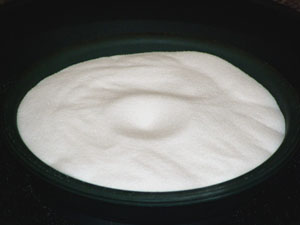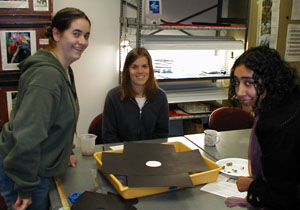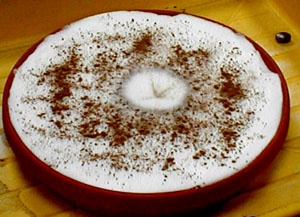Explorations with impact.

Craters made by dropping two steel balls into a planter filled with
salt.
The salt is covered with spices.
Explorations with impact.

Craters made by dropping two steel balls into a planter filled with
salt.
The salt is covered with spices.
Introduction
Craters can be made by dropping steel ball bearings into a tray of salt or sand. These craters share several properties with impact craters in the solar system: The crater is much larger than the impacting object, the crater is circular even if a non-spherical object hits at an angle, and debris is ejected a long way from the crater.
Material
Assembly
Fill the tray with salt to a depth of 5 cm (2") or more, more is better, as much as 10 cm.
Put black paper around the sides of the tray to catch salt ejecta and show its pattern.
To Do and Notice

Drop the ball bearing into the salt from a height of 25 cm
(10").
Notice that the ball bearing creates a crater and disappears from
view.
(If the ball bearing doesn't disappear make a deeper layer of
salt.)
Notice that the crater is circular, and larger in diameter than the
ball bearing, and notice how ejecta sprays out around the crater.
Notice that there is a raised rim around the crater.
Drop an identical ball bearing from a height of 1 meter (1 yard) notice that the crater is larger and the ejecta sprays further.
Recover the ball bearings from the salt by coming through the salt
with your fingers with a rake from a cat litter box or by using the
magnet.
If you have a non-spherical fishing weight, drop it into the salt and
notice that the crater is circular even though the weight is not.
Roll the ball bearing down a grooved track or through the PVC tube
so that it hits the salt at an angle.
Notice that except for very low angles (measured from the surface),
the crater produced by the ball bearings is circular.
Cut a hole in the construction paper larger than the craters you
have produced.
Smooth the tray of salt and cover it with the black construction
paper.

Drop a ball bearing into the salt through the hole in the
paper.(Guide it with the PVC tube.)
Notice that salt is ejected a long way onto the paper compared to the
diameter of the crater, this salt is called the ejecta.
Launch the ball bearings into the salt through the hole at an angle,
notice that the ejecta pattern is not symmetrical. More is scattered
forward than backward.
Sprinkle cocoa powder or spices onto the surface of the salt.
Notice the pattern of powder after the impact. Notice that powder
near the rim of the crater is covered in salt.

What’s Going On?
In cratering of a planetary surface, the impacting object delivers
a large amount of kinetic energy to the surface. This energy spreads
out like the energy from an explosion, creating a circular crater
that is larger than the impacting object.
When we drop an object into salt the kinetic energy of the impact of
the object is transferred to the salt which sprays out in a circular
pattern.
The ejecta is thrown a long distance from the crater.
When an object impacts the surface at a low angle from the surface,
the ejecta does not spread out in a circularly symmetric pattern.
Most of the ejecta continues on in the direction in which the
meteoroid was traveling. Little ejecta goes back along the path from
which the meteoroid arrived. The same thing happens in our model of
an impact.
So What?
Craters are the most common feature on most planetary
surfaces.
The earth is an exception since erosion has removed traces of
craters..
Large objects are completely vaporized by the energy of their impact,
their kinetic energy creates an explosion that is more than 100 times
greater than if they were made of TNT.
Math Root
Measure the diameter of the crater, measure the circle made by the
crest of the raised rim.
For a given height of drop, computer the ratio of the diameter of the
crater to the diameter of the ball bearing.
Make a plot of how the diameter of the crater depends on the height
from which the ball is dropped.
Calculate the energy of the impact. E = mgh
where m is the mass of the impactor in kg, g is acceleration of
gravity, 10 m/s2, h is the height of the drop.
For example a 10g ball dropping 1 meter has energy of: E = 0.01 * 10 * 1 = 0.1 Joule.
TNT releases about 1 Calorie per gram so if this this 10 gram ball were explosive then it would release 104 calories or 50,000 Joules.
As a meteorite travelling at 20 km/s it would have an energy of E = 1/2 mv2 or 0.5 * 0.01 * 4 * 108 = 2 x 106 Joules.
Going Further
Record the impact with a digital video camera and play the impact back in slow motion one frame at a time.
Notice the expulsion of the ejecta, the creation of a crater, and the modification of the crater by slumping.
Etc.
A meteoroid is a rock.
A meteor is a flash in the sky.
A meteorite is a rock from space which makes it to the ground
Meteoroid impacts ejected rocks from the Moon and from Mars which
eventually reached the earth.
In 1911 in Nakhla, Egypt, a rock from Mars fell to earth. It hit and
killed a dog.
|
Scientific Explorations with Paul Doherty |
|
28 November 2000 |